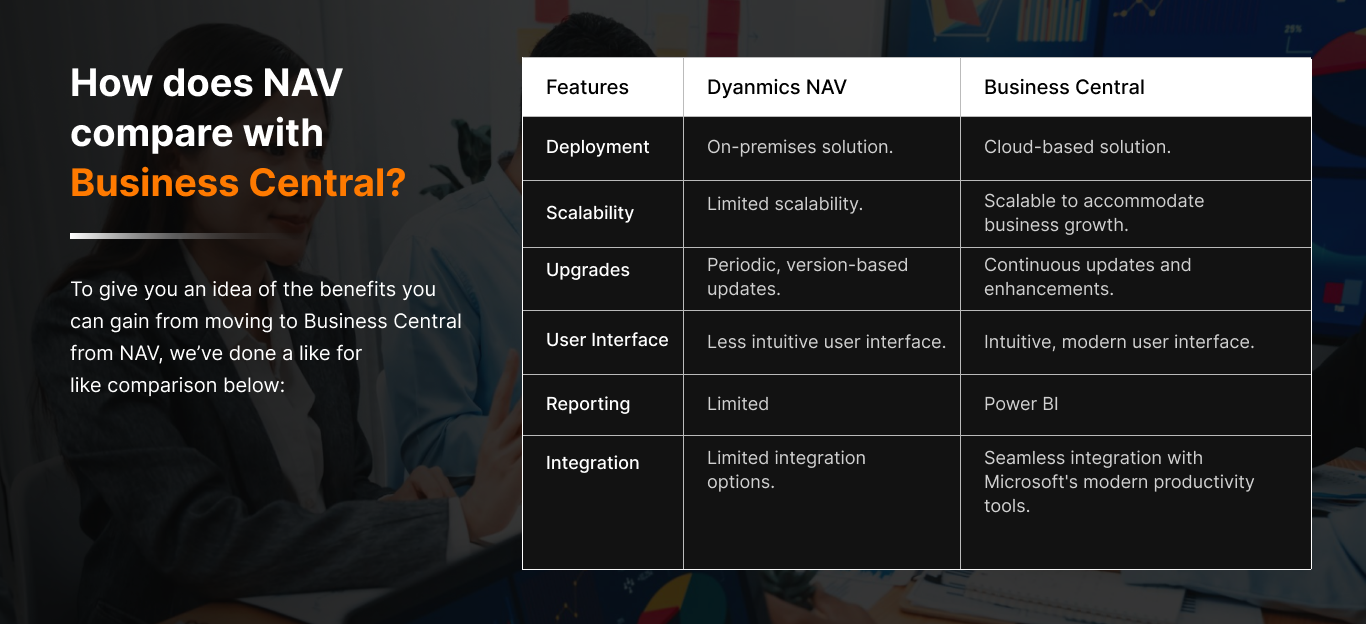One significant aspect of this adaptation is the technology that drives your operations. For businesses currently using Microsoft Dynamics NAV (formerly Navision), the question often arises: Is it time to migrate to Microsoft Dynamics 365 Business Central?
We will delve into the reasons behind making the transition, the process of migration, a comparison of NAV with Business Central, and why the latter should be the choice for your business.
Why Should Your Business Move from NAV to Business Central?
Embrace Modern Cloud Technology
Business Central is a cloud-based solution, whereas NAV relies on on-premises infrastructure. The cloud offers numerous advantages, including scalability, accessibility, and cost-efficiency. With Business Central, you can access your data and applications from anywhere, on any device, promoting flexibility and remote work.
Stay Up to Date with Continuous Updates
Business Central receives regular updates and enhancements from Microsoft, ensuring that your ERP system remains current with changing business needs and evolving compliance requirements. NAV, being an older version, might struggle to keep up with these ongoing advancements.
Enhanced User Experience
Business Central boasts an intuitive, user-friendly interface that simplifies navigation and usability. This improved user experience can lead to increased productivity and employee satisfaction, which are crucial for business success.
Advanced Analytics and Reporting
Business Central offers robust built-in analytics and reporting capabilities, powered by Power BI. This enables you to gain deeper insights into your data, make data-driven decisions, and identify trends and opportunities faster than ever before.
Integration Capabilities
Business Central seamlessly integrates with other Microsoft products like Office 365, Power Platform, and Azure, making it easier to create a unified technology ecosystem within your organization. NAV may have limitations when it comes to integration with these modern tools.
How Do We Move You from NAV to Business Central?
We as Microsoft Solution partners have been helping companies Migrate from Dynamics NAV to Business Central, which involves careful planning and execution. Here’s an overview of the process:
| Step | Description |
|---|---|
| Assessment and Planning | Conduct a comprehensive assessment of your existing NAV setup. Identify customizations, data, and integrations that need to be transferred. Create a migration plan that outlines timelines, resource allocation, and potential challenges. |
| Data Migration | Ensure that your data is cleansed, validated, and transformed for compatibility with Business Central. This step is critical to maintain data integrity during migration. |
| Customizations and Extensions | Review your existing customizations and assess whether they can be replicated in Business Central. Business Central supports extensions through AL (Application Language), allowing you to tailor the system to your specific needs. |
| Training and User Adoption | Prepare your team for the transition by providing training on the new system. User adoption is crucial for a successful migration, so invest time and resources in ensuring your employees are comfortable with Business Central. |
| Go-Live and Support | Execute the migration plan and carefully monitor the transition process. Address any issues promptly and provide ongoing support to ensure a smooth post-migration experience. |
Why Should Your Business Choose Business Central?
Business Central’s cloud-based architecture, continuous updates, and integration capabilities make it the ideal choice for modern businesses. Here are some compelling reasons to opt for Business Central:
- Scalability: Easily scale your ERP system as your business grows without the need for significant infrastructure investments.
- Data Insights: Leverage advanced analytics and reporting to make data-driven decisions, gain competitive insights, and identify growth opportunities.
- Flexibility: Customize and extend Business Central to suit your unique business needs with ease.
- Collaboration: Seamlessly integrate with Microsoft 365 tools, enhancing collaboration and productivity across your organization.
- Cost-Efficiency: Reduce IT infrastructure costs by utilizing Microsoft’s cloud services while benefiting from a pay-as-you-go model.
Dynamics NAV to Business Central Migration Package
Migrating from Dynamics NAV to Business Central is a strategic move that can propel your business into the future. To facilitate a smooth transition, consider consulting with us experienced Microsoft partners who offer migration packages tailored to your specific needs. These packages include ensuring a successful migration and maximizing the benefits of Business Central.
In conclusion, migrating from Dynamics NAV to Business Central is not just a technological upgrade; it’s a strategic decision that can position your business for growth, agility, and success in the digital age. Embrace the future of ERP solutions with Microsoft Dynamics 365 Business Central and empower your organization to thrive in today’s competitive landscape.
Let’s Build Digital Excellence Together











